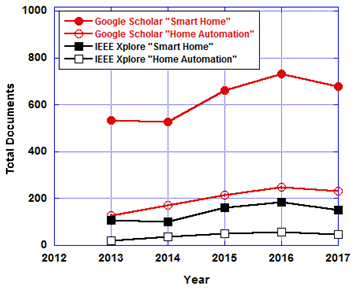eISSN: 2641-936X


Opinion Volume 2 Issue 1
University Center of Excellence on Microelectronics, Institut Teknologi Bandung IC Design Laboratory, Indonesia
Correspondence: Syifaul Fuada ,University Center of Excellence on Microelectronics, Institut Teknologi Bandung IC Design Laboratory, PAU building 4th floor, ITB campus, Jln. Tamansari No. 126, Bandung city (40132), West Java, Indonesia
Received: January 03, 2018 | Published: April 19, 2018
Citation: Fuada S, Adiono T. The importance of lightweight implementation concept for nodes in smart home system. Electric Electron Tech Open Acc J. 2018;2(1):15-18. DOI: 10.15406/eetoaj.2018.02.00015
The lightweight concept for nodes in the smart home system is presented in this short note. By this concept, ease in the installation of the smart home device to the user can be reached. Then, the opportunity to mass deployment viewed from the developers is high. It means can be conducted.
Keywords: lightweight concept, nodes, smart home system
Today, the exploration of home automation (or even known as smart home) is one of several top engineering research in the global. Although the smart home is an old topic, we think it still grows, high interest, and became an engaging discussion especially in the developing country such as Indonesia. There are mucg scientific report on the smart home that can be found in the Google Scholar search engine, IEEE Xplore digital library or other major databases, for example:1 Figure 1 reports the trend research on the smart home system that has been achieved from two popular databases. We can see that the charts tend to increase year by year. As the summary of our observation, many research on smart home system usually discussed specific case of issues and applications as depicted in Figure 2, such as

Figure 1 The illustration of research trend over the last five years by visualizing the number of search results for the search term “allintitle: Smart home” and “allintitle: home automation” conducted using the Google Scholar and IEEE Xploreonline lib.
Then, the development of the smart home system can be classified into five aspects as shown in Figure 3, i.e. central control system, security monitoring, residence monitoring, information appliances, and energy saving. The devices at smart home viewed from its purpose can be classified into three parts, i.e.
The monitoring devices cover sensors and multimedia. In this function, the user takes action to “request” something into the host system, and then the sensor sends the notification sensing data, such as temperature and humidity monitoring. While the function of control devices is the user gives specific “command”. Therefore it enables the user to control their home environment, for examples: controlling the curtain, the fan, the lamp, etc. The emergency warning function is for “informing” the user in which they receive specific notification directly without making a request before by user, for example burning detection (fire alarm), toxic gases detection, thief detection, etc. Indeed, the smart home system is designed, implemented, and dedicated for human activity for all ages (from an elder to people with particular disabilities) who wish to make their life activities become more natural and feel comfortable. It will be serving assistance for human without disturbing their resident’s daily routine and will be giving greater pleasure. Thus, the smart home system should easy to operate for everyone (with permission first) and also low-effort to install it in their residence. One of crucial intelligent home implementation is that it must comply with the user-friendly requirements and light-weight recommendations at initial install without significant effort with replace the conventional system to a smart system (significant changes). The node is one part of the whole of the smart home environment. We think that the careful development of its hardware needs to the full fill the requirement of consumer orientation (packaged ergonomically and practically way with appealing packaged/boxed of its hardware). Thus, users of smart home technology and developers of the smart home system will equally benefit. For users: easy to install in initial use and comfort to manage their system. While for the developer: it can support the efficient deployments. As an example of the node product that put forward the concept of smart home’s lightweight implementation, we introduce our R&D in smart-home, namely ‘MINDS’. This system is from our academic research in Microelectronic research center of Bandung Institute Technology.2–7 The nodes cover control-based (door lock, curtain control, lamp switcher, RGB ambient control lamp) and indoor environment monitoring-based (humidity and temperature sensors). This product (http://minds.id/) is addressed to every people that are elderly, healthy people, disabled persons. This paper will describe our proposed hardware structure for lightweight implementation of nodes smart home, while the ergonomic design focus will be explained in another paper. We hope by this paper, it will provide a positive reference for the new start-up in developing specific node.
In our opinion, the box of node must be packaged into compact-size in which consist of communication module (such as Bluetooth, NFC, Wi-Fi, or Zigbee) controller kit for digital signal processing (microcontroller), specific electronic circuit for analog signal conditioning or driver, indicator (if necessary used), external battery as well as charger circuit (if necessary) and regulator circuit/power supply. Figure 4 depicts the circuitry concept of each node for the smart home, while Figure 5 are the realization of the node

Figure 4 Node circuitry concept reproduced.2
In summary, the aspects of easy in use (user-friendly) and its hardware installation of a smart home system to users should take precedence. Whereas viewed from the smart home developer side, this concept will also simplify the mass production process.
This work is one part of the big project entitled “Perangkat Internet-of-Thingsuntuk Sistem Rumah Cerdas” that was funded by the Ministry of Research, Technology and Higher Education of the Republic Indonesia for Decentralization scheme (009/SP2H/LT/DRPM/IV/2017).
Authors have declared no conflict of interests.

©2018 Fuada, et al. This is an open access article distributed under the terms of the, which permits unrestricted use, distribution, and build upon your work non-commercially.